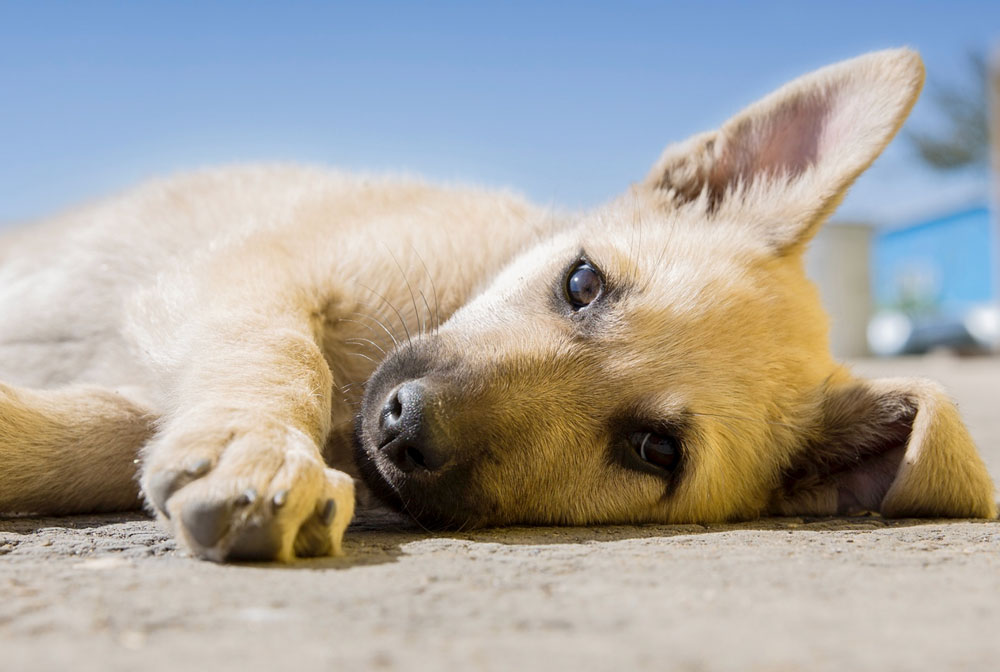CPV, CPV2, or just “parvo”) has been sickening and killing dogs and puppies since 1976, the year it first emerged in dogs. The illness caused by the virus, characterized by severe vomiting, bloody diarrhea, and lethargy, first affected dogs in Europe. Within two years, however, the virus had spread throughout the world. Uncountable thousands of puppies and dogs who were infected with parvovirus died before the parvovirus vaccine was developed that could prevent the disease.
The market introduction of the parvo vaccine in 1979 and release of an improved vaccine in 1981 relieved dog owners worldwide; finally, there was protection available to prevent the deadly disease. But puppies and dogs who are exposed to the virus before being fully immunized against it still run a strong risk of becoming infected and fatally ill.
Parvo symptoms
The signature symptom of parvo in dogs is severe gastroenteritis (inflammation in the stomach and intestines), which causes vomiting and diarrhea that is often profuse, liquid, bloody, and foul-smelling, and a loss of appetite. Affected dogs and puppies will exhibit extreme lethargy (lack of energy and enthusiasm).
Parvo in puppies usually hits hard and fast. Puppies with parvo are not likely to be acting fine except for diarrhea. They usually look pretty pathetic, sad, and act like they feel awful. They frequently have fevers and abdominal pain. They quickly become dehydrated and sometimes anemic, which makes them sicker and weaker. The younger the puppy, the harder it hits. By the time they are presented to a veterinary hospital, many puppies are in shock (a life-threatening emergency where blood flow is impeded, leading to organ shutdown and death).
Unvaccinated adult dogs can get parvo, too. But because adult dogs have stronger immunity and better mechanisms to fight dehydration and shock, they usually recover more quickly and generally have a better prognosis than puppies, although it can still be fatal.
How do dogs get parvo?
In order to contract parvovirus, an unprotected dog or puppy has to come into contact with feces from an infected dog. The virus gets into the dog through the nose and mouth; a puppy or dog can get it from sniffing, licking, or eating the feces of an infected dog – or just stepping in it and then licking their paws.
The virus is very hardy. It can live for months to years in the environment, which means contaminated surfaces, bowls, and toys are threats. Many disinfectants are ineffective against parvovirus, but diluted bleach kills the virus if left on the infected items for at least 10 minutes.
Treatment for Parvovirus
Because parvo can be deadly, the goal should be to prevent infection, not to treat it afterward.
Since it’s a virus, it can’t be treated with antibiotics. Instead, most veterinarians focus on treating the symptoms so that the dog’s own immune system can work to fight off the invaders. In most cases, dogs with parvovirus will need to spend time at a veterinary hospital to get the care they need.
Treatment may include:
-Intravenous fluids (IV) to replace those lost to diarrhea
-Blood transfusions to help keep blood cell counts high
-Anti-nausea and anti-diarrheal medications to help dogs retain fluids
-Antibiotics if the dog has come down with secondary infections
How to prevent parvo
The parvovirus vaccine is the mainstay of prevention of this disease. It is highly effective against the virus. It is rare for an appropriately vaccinated dog or puppy to come down with parvo.
Puppies should be vaccinated every three to four weeks, starting at 6 to 8 weeks of age until they reach 16 to 20 weeks of age. As young adults, a booster is recommended initially annually, then every three years.
Additional preventive measures you can take to prevent parvovirus include:
If possible, get a puppy from a vaccinated mom. She will give her pups temporary immunity through her colostrum (first milk).
Limit your pup’s exposure until fully vaccinated. This does not mean keeping him in a bubble; that would make him miss out on critical socialization and confidence-building opportunities when they are the most important.
Just use common sense; avoid areas where unvaccinated dogs are likely to be, such as strays, and watch where your puppy is sniffing, since the virus is found in feces. Pick the puppy up and don’t allow him to touch the floor in high-risk environments, like the veterinarian’s waiting room or at highly trafficked pet supply store or public park.
The bottom line on parvo? There’s good news and bad news. The bad news: Without treatment, almost all infected puppies will die. The good news: With treatment – even outpatient treatment – most puppies will survive. Survival rates are as high as 90% for inpatients, and more than 80% for outpatient puppies.
The best news of all? Parvovirus is easily prevented by vaccination.

